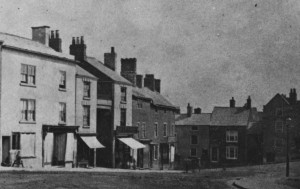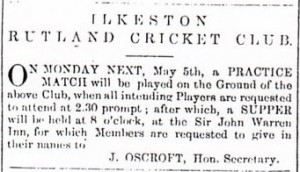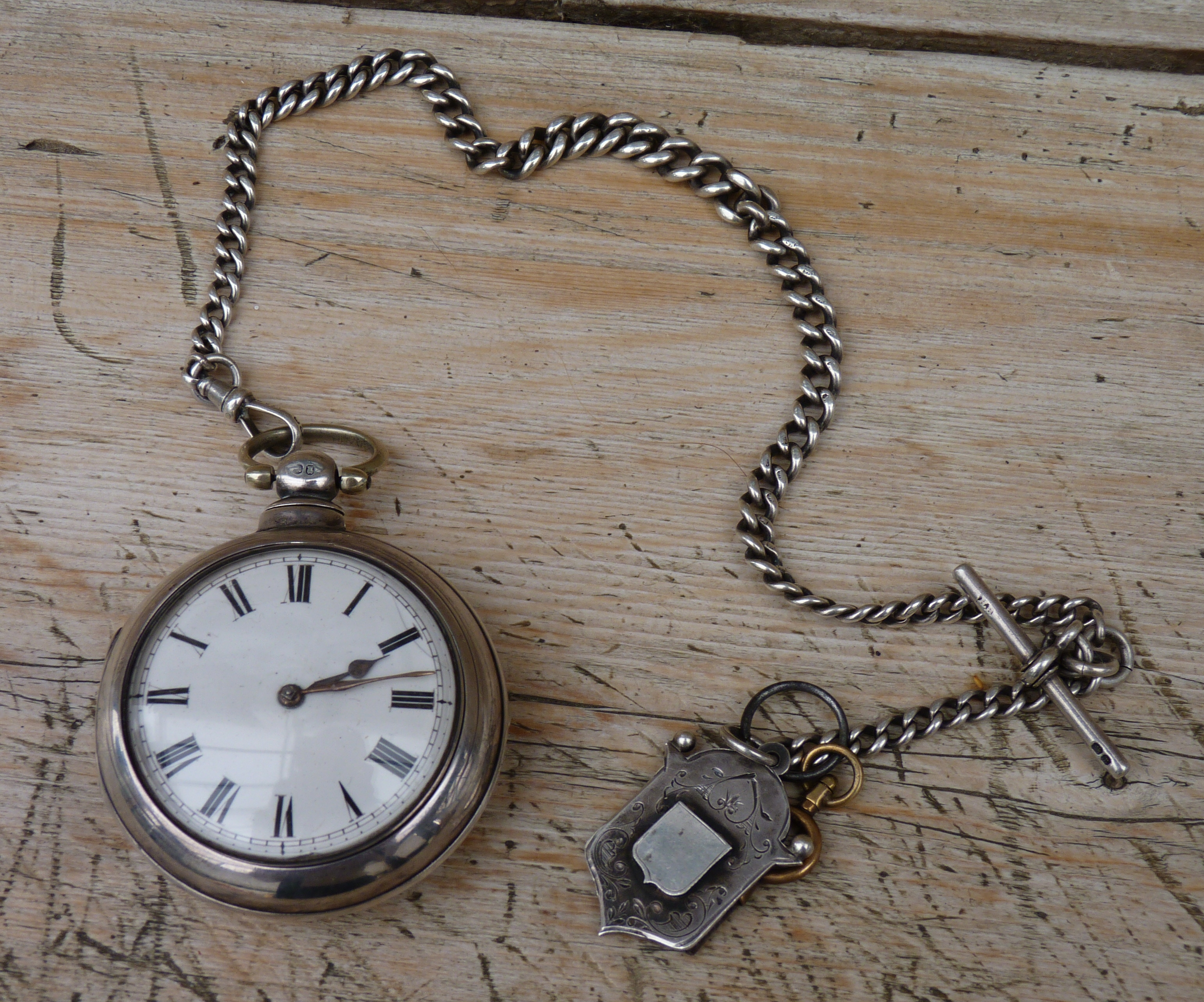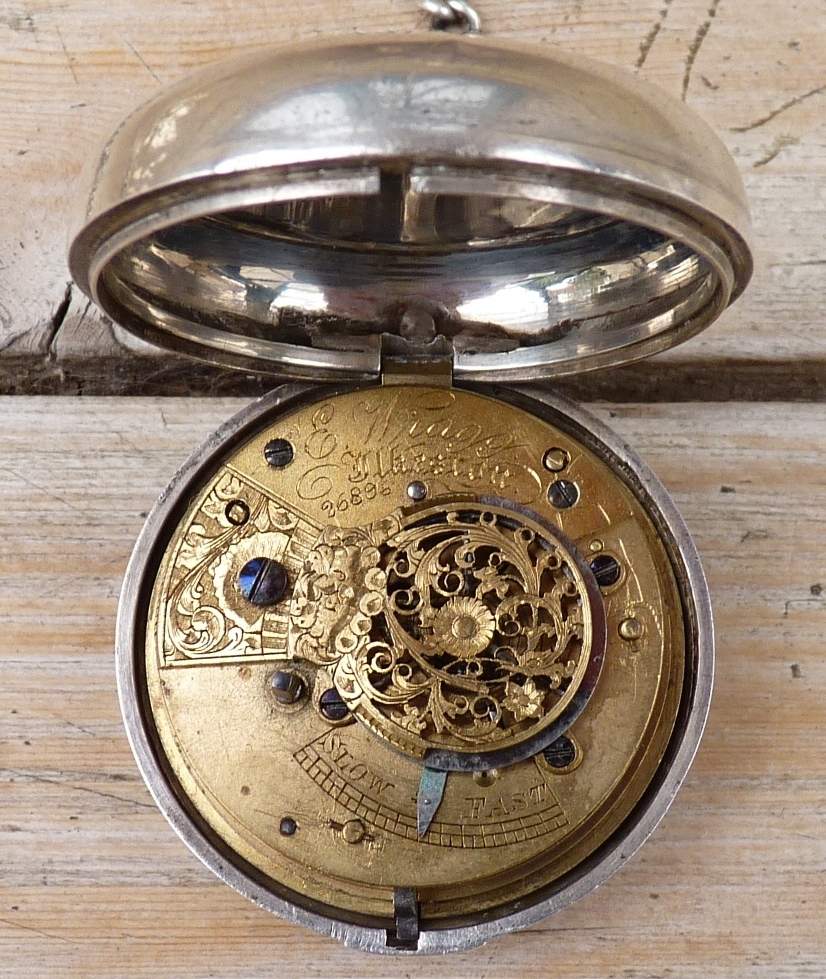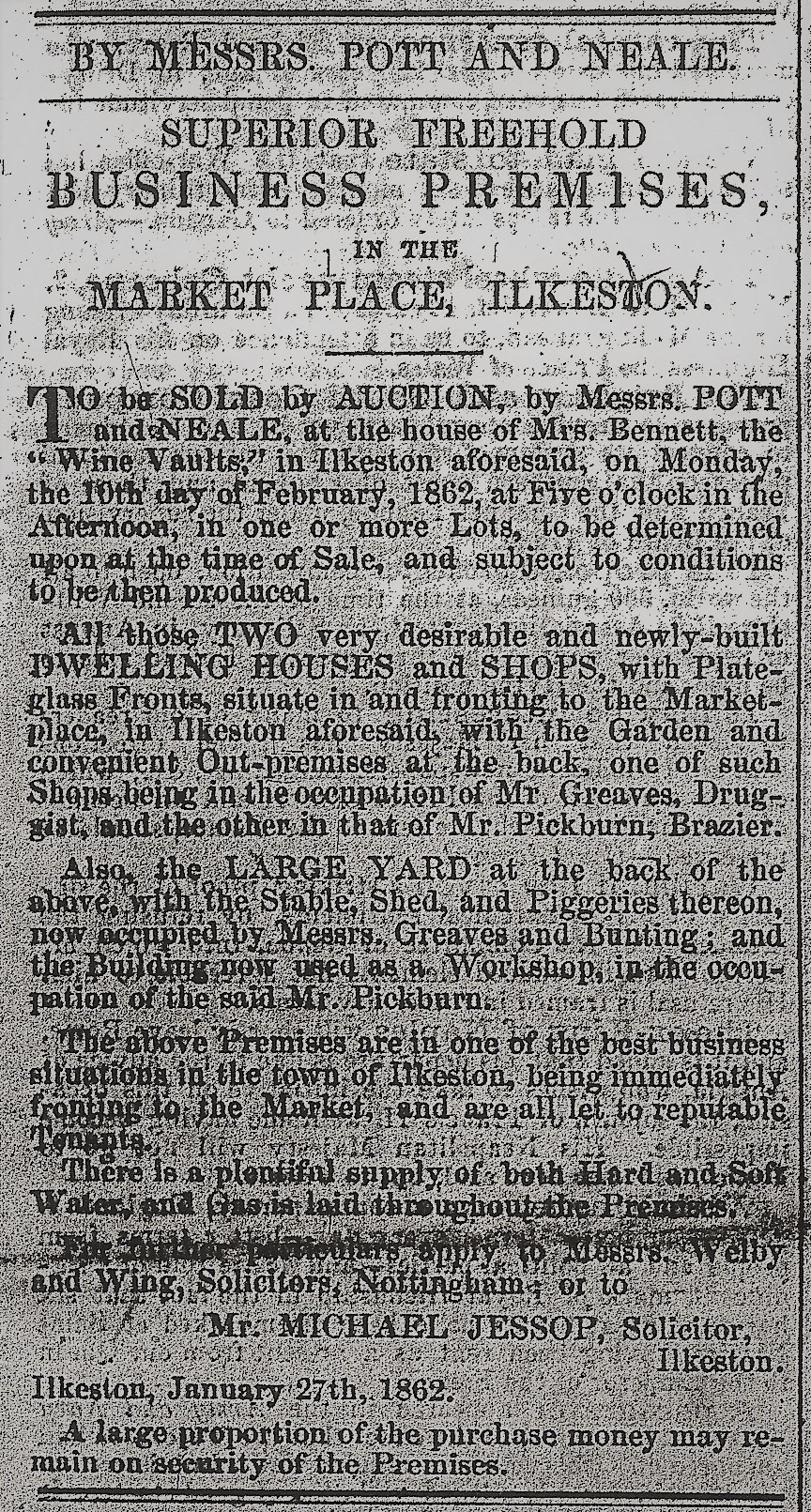We are now about to walk from Inn to Inn … from the Old Harrow Inn, along the north side of the Market Place, towards Pimlico and the Sir John Warren.
The northern side of the Market Place in the late 1870’s. (courtesy of Ilkeston Reference Library)
In this photograph the opening between the two premises displaying window awnings led to what was once called West’s Yard.
To the east side of the opening – on the right in the photograph – was number 9 Market Place, the premises of Charles Henry Bourne in the late 1870’s. To the right of that were numbers 10, 11, 12 and 13 Market Place, before the Old Harrow Inn (number 14) — which is just out of sight.
————————————————————————————————————————————————
Chemists and druggists
Adeline tells us that “in the Market Place, starting from the Old Harrow Inn, two new shops had been built…. the first one being empty for a long time”.
This first shop was 13 Market Place (1871/81) and housed a succession of chemists and druggists. It had been opened in April 1859 by Abraham Greaves, chemist and druggist of Ironville, a trader in that town for over 20 years — since 1836.
Mr. W. Allsopp, a chemist and druggist, started his business in it.
The 1861 (April) census shows it occupied by chemist and druggist Walter Allsopp — who had managed the business for Abraham Greaves since its opening – and his wife Ann (nee Hunt).
In 1864 Abraham bought a shop in Chesterfield and in the following year sold his Ilkeston wholesale and retail chemist ‘business’ to his manager Walter.
Walter and his family moved to Chesterfield in 1870 and these premises were then occupied by James Oscroft, chemist.
The Oscrofts
Born in Chesterfield in 1848, James Oscroft married Sarah Elizabeth Hall in Manchester in 1870, about a year after the birth of their first daughter there. By April 1871 – the date of the census – they were living at their Market Place address in Ilkeston.
In July 1872 James Oscroft was granted a license to sell petroleum by the Local Board but as he was intending to keep a large quantity of the flammable liquid he would have to construct a separate building to store it.
From the Ilkeston Pioneer May 1st 1873
James’ proximity to the Old Harrow Inn was causing him problems in 1878.
Directly opposite his sitting room window and only 12 feet away was one of the Inn’s urinals, overflowing the public footpath and causing a severe discomfort to the chemist. Landlord Joseph Aldred had been ordered by the Local Board to brick up part of its entrance or move it to another position on the premises but having failed to comply, he was now charged and convicted under the Public Health Act of 1875 of allowing a nuisance urinal.
Sheddie Kyme remembered James Oscroft as “a poultry fancier,(who) gained many prizes for his bantams”.
For example, at the Southwell Agricultural Show of October 1876 James’s bantams secured a third prize in the category of ‘Game Bantams, Black and Brown Reds’. And a couple of months later, at the annual Christmas Ilkeston Cattle and Poultry Show, James won several of the poultry classes contested there.
Sheddie continued. “But what a character Mr. Oscroft was! I have no doubt he was a very good business man, smart and alert in every way, but he was one of the most irritable persons it was ever my lot to come into contact with. When crossed, his vocabulary would run riot, and the words flow from his lips at the rate of about 200 a minute. But in this respect he was perhaps seen at his best when drawing a molar. Mr. Oscroft came to a rather sad and untimely end, mental trouble, I believe, being responsible for his death”.
In a notice, dated December 24th 1879, which was to appear on the front page of the Pioneer, ‘Mrs. James Oscroft’ wrote that she …
“Begs most respectfully to thank the inhabitants of Ilkeston and neighbourhood generally for the very flattering support and confidence reposed in her husband, previous to his severe indisposition, and to inform them that she has secured the services of a Registered Chemist and Surgeon Dentist of thirty years’ experience, in whom she feels justified in placing great confidence, and solicits a continuance of those favours on behalf of herself and little family”.
Her ‘little family’ members were daughters Florence Hall Oscroft (born 1869) and Mary Louisa Hall Oscroft (1874), and son James Hall Oscroft (1876). Not in the family were daughter Sarah Elizabeth who was accidentally suffocated in December 1871, aged 14 weeks, and son Richard Hall Oscroft who died of bronchitis in February 1873, aged 3 months.
A month after this notice in the Pioneer, James Oscroft died — on January 23rd 1880, aged 31.
His widow now had to write a second note, again to appear in the Pioneer.
S. E. OSCROFT (Widow of the late James Oscroft,) CHEMIST & DRUGGIST, 13, MARKET PLACE, ILKESTON.
Begs to return thanks for favours so liberally bestowed upon her late husband, and to inform the inhabitants of Ilkeston and neighbourhood that it is her intention to continue the business, under the supervision of an efficient Manager, and trusts she may receive a continuance of generous patronage as in the past.
Market-place, Ilkeston, February 3rd, 1880.
And two weeks later Sarah Elizabeth added a post script to her second note — ”teeth carefully extracted”.
In December of 1880 widow Sarah Elizabeth married Thomas Murdoch, a Scottish chemist, and the family continued trading at the same place. … under the name of the ‘Ilkeston Apothecaries’ Co’.
A Victorian Chemist’s shop
Born in 1857 at Ripley, Derbyshire, George Samuel Gothard Webster had been assistant chemist to Charles Fence in London when about 1884 he came to Ilkeston to trade at this shop. He was still there in 1888 by which time the premises on this side of the Market Place had been renumbered … the chemist shop was now number 16. And in 1891 he was still trading here though living with his mother in Ripley. An he was there at the turn of the century.
——————————————————————————————————————————————————–
Edwin Wragg vs John Poole
“Next (the second shop) was Mr. Wragg, with all kinds of carpet, cloth, American and leather travelling bags. I remember Mr. Wragg selling off his stock, and Mr. Pickburn removing into the shop”.
Meets an old immovable object like me
You can bet just as sure as you live
Something’s gotta give
Something’s gotta give” (Johnny Mercer)
In the red corner …..
Born in 1826, Edwin Wragg, watch and clockmaker, was the son of earthenware manufacturer James and Martha (nee Fidler) and in 1854 married Ann Jessop, the younger sister of Crich solicitor Michael Jessop.
The couple came to Ilkeston but shortly after the birth of their second child in 1856 Ann died, as did the child, Martha Ellen.
Having traded for about five years in Ilkeston — his last premises being opposite the Pioneer offices in Bath Street — Edwin Wragg opened his refurbished shop in the Market Place in January of 1858. Prior to this he had spent some months improving the property and this seems to have been the genesis of a protracted feud with John Poole, the editor of the Ilkeston News at that time.
…. and so, in the blue corner
John Poole had traded as a printer in Ilkeston since 1853 and in January 1855 he had come to rent the Market Place shop and house then owned by Joseph Bennett who lived in the house next door. In 1856 Joseph left to live in Stanley Common and for a time let his own vacated property to wheelwright Joseph Scattergood before eventually selling it to Edwin.
Seconds away !! … Round 1
In February 1857 the watchmaker took possession of the property and about six months later started to make extensive alterations, extensions and additions to the premises and in the back yard which was jointly occupied by John Poole and Edwin. The editor was extremely miffed by all this building work, especially as he claimed not to have been informed or consulted about it. He complained of course, but Edwin was dismissive and on one occasion merely showed John his backside and said ‘kick this’ – at least it sounded like that !!
Round 2
Smalley Petty Sessions of October 1857 seems to have been the first occasion that the two clashed in court. Edwin charged John and his wife Catherine (nee Smith) with assault but not for kicking Edwin’s backside.
Edwin testified that while he was visiting the premises that he was altering, an argument with the two Pooles developed. John struck him while Catherine pulled his hair and blacked his eye. In his defence the editor stated that he had been sorely provoked and his wife had been threatened by Edwin. Their argument continued in court where the language became fruitier and unfit for publication — or so the Pioneer piously reported.
The magistrates longed for the neighbours to live quietly and while considering that the offence had been proven, imposed only a small fine on the Pooles. Magnanimous Edwin declined to take his expenses.
The wishes of the magistrates were not to be realised.
Round 3
On the very day that they had appeared in court the feuding households were again involved in an alleged assault, leading to another appearance at Smalley Petty Sessions. Once more Edwin was the plaintiff. In court he testified that on that October night he had returned from Elizabeth Bennett’s Wine Vaults in East Street at about midnight to find the gate to his back premises locked. This was highly unusual as the gate, nearly seven feet high, was normally left open. Not wishing to disturb anyone, the considerate watchmaker was attempting to climb over the gate when John appeared, pulled him down from the gate, punched him in the eye and ran off into his own adjoining house.
Before the court hearing, the Pioneer published details of the attack.
It already judged the case and found John ‘guilty’ although it did not name him.
It reported that a ‘dastardly assailant’ had seized Edwin, thrown him to the ground, violently assaulted the prostrate watchmaker and left him with a damaged right eye which had just recovered from ‘the effects of an attack thereon by a lady-pugilist‘. Pursued by a remarkably-recovered Edwin, the coward then ran off and exited the scene through a door near the Old Harrow Inn which had been opened for him and which was quickly closed and fastened. This house of refuge sufficiently attested to the identity of the coward. The Pioneer advised the watchmaker to have the ‘midnight boxer bound over to keep the peace, or otherwise legally restrained from indulging in his cowardly fighting antics’.
However, on to the Petty Sessions and several witnesses were called to cast doubt on the watchmaker’s story while poor Edwin had forgotten to obtain similar assistance such that the magistrates dismissed the charges against John and ordered Edwin to pay 25s expenses.
Round 4
Two months later and it was John’s turn to appear as plaintiff when he sued Edwin in Belper County Court in a civil action for damages to and trespass upon his property.
Edwin’s alterations were again the cause of complaint and several prominent Ilkestonians were called as witnesses, including builder brothers Robert and Jedediah Wigley, Inspector of Nuisances Samuel Pounder, joiner James Smith, wheelwright Joseph Scattergood.
In his evidence, stationer John stated that he was now a tenant of Edwin, that he had joint use of the back yard, that he once had a hen-house supplied by the previous owner Joseph Bennett, that at the rear of the house used to be a beautiful grass area where his wife would walk and with a nice paved area. Since then Edwin had built a kitchen for himself, within three or four feet of John’s back door, obstructing light and air. Consequently the grass area has now disappeared. John had also had his hen house pulled down by Edwin when Samuel Pounder, the Inspector of Nuisances had ordered the latter to improve the privy — to replace the exisiting one with two privies, one for each house. But even though John now had his own privy he was still not satisfied — it is open for the tinkers and all other shops in the yard !! He had also lost his water tub through the alterations, but now had a cistern and pump !!
John was awarded damages, mostly for the annoyance caused while the work was in progress and for the loss of light and air caused by the alterations. Though not as much as he claimed; and the judge clearly thought that the matter should have been settled long ago without recourse to law.
Round 5
At the same court and on the same day but in a separate action John claimed that he had been overcharged by Edwin, for a watch, clock and other goods, and was again awarded damages and costs.
Verdict ….. The magistrate was of the view that the people of this town were never reluctant to use the courts.
“For what do we live, but to make sport for our neighbours, and laugh at them in our turn?” (Jane Austen)
And on September 12th, 1858 Edwin married Mary Marshall, oldest surviving daughter of grocer Thomas and Catherine (nee Jackson), whom we shall meet shortly, living a few doors away. (next to the King’s Head).
This union appears to have been an unhappy one. Late in 1860 Edwin was charged with assaulting Mary, was found guilty and was ordered to pay costs of 23s or be committed to prison.
Thereafter Mary appears to have lived with family members and died, still separated from her husband, in July 1877.
Decline and fall
About 1860 Edwin returned to the Chesterfield area to lodge with his parents at Stonegravels … but the lodger couldn’t stay out of trouble and argued with all his relatives.
For example, in May of 1862 he was charged with using abusive and threatening language against his brother Charles, with assaulting Charles’s wife and then his brother by pulling their hair. Edwin couldn’t be bothered to turn up to court when the case against him was heard … a warrant had to be issued to get him before the Magistrate, who subsequently bound him over to keep the peace for six months. Edwin just made it !!
In December 1862, Edwin was at it again and this time his target was his parents. His father James, a pot maker, was returning home from work one Thursday evening when, passing the Devonshire Arms, he met a thoroughly intoxicated Edwin in the street. The couple began to argue, an argument which continued on the way home where James found his wife Martha covered in blood after being assaulted by Edwin. A subsequent wrestling match between father and son was only brought to an end by the intervention of the police who took Edwin into custody. At Chesterfield County Police Court Edwin described the affair as a ‘scrimmage’, not a description which the magistrate agreed with. Edwin was given the choice of a large fine with costs, payable immediately and in full, or six weeks in prison with hard labour. It seems that he chose the latter.
One Monday evening in April 1863 a drunken Edwin — unsurprisingly no longer lodging with his parents — arrived at their home at Stonegravels, demanding to see his daughter (Ann Elizabeth?) who was in bed. He became very agitated, picked up a poker and threatened violence to several of those present. Constable Charles Wright was sent for but not before Edwin had done serious damage to two panes of glass. He was then handcuffed but not very effectively!! He slipped out of the cuffs and into more serious bother when he assaulted the constable.
At Chesterfield Police Court Edwin was fined for both offences, with the obligatory jail term if he refused payment. Edwin spent the next four months in jail.
In November 1863 he appeared at Chesterfield Borough Police Court charged with wilfully breaking a gas lamp, the property of the gas and water company. He admitted that he sometimes drank too much but he wasn’t drunk when he committed this offence, for which he pleaded guilty.
Edwin chose to spend a week in jail rather than pay the fine of half-a-crown plus costs.
Edwin was a seriously troubled individual, seemingly unable to control either his temper or his drinking, the latter adversely affecting his health and causing him to seek out confrontations, quite often with his relatives.
In March 1864 he travelled to Crich where he set fire to two stacks of wheat belonging to solicitor Michael Jessop, brother of his first wife Ann, and causing £100 of damage. His motive was alleged to be one of revenge: he accused Michael of selling his house without his consent. He also had it in for Michael’s legal clerk whom he accused of robbing him of £13.
At the subsequent trial, July 16th, at Derbyshire Midsummer Assizes, where Edwin pleaded guilty, both the prosecution and the magistrate thought it beneficial to have the defendant’s state of mind examined carefully by Henry Gisborne, the prison surgeon. This revealed that Edwin was of sound mind and so — his previous convictions for assault and wilful damage taken into account — he was sentenced to five years’ penal servitude.
As he was leaving the dock, Edwin took a swipe at the head of Michael Jessop’s clerk who was stationed nearby … the clerk was none other than Hubert Henri Sugg.
(At the same court at the same time for the same offence and by the same judge, collier William Burgess of Dronfield was sentenced to three years in penal servitude; it appears that Edwin’s motive of revenge had aggravated his crime and added two years to his sentence).
Edwin began his sentence at Derby, serving four months before being transferred to Leicester jail where he spent the next ten months. During this time he earned several warnings, for insolence, disobedience, and irreverent conduct during Divine Service. A more ‘serious (?) black mark’ came during association exercise in the prison yard, when Edwin was repeatedly reprimanded for turning his head, laughing at other prisoners and not keeping his distance from them. Interestingly the surgeon who subsequently examined him thought him ‘not a fit subject for punishment’. From Leicester Edwin went to Portland Prison, eventually to receive an Order of Licence, dated September 30th 1868 — effectively this was his ‘Get Out Of Jail’ card, — he would be released from custody under certain conditions, and be allowed to live within the community, so long as he was not convicted of an indictable offence during the remainder of his sentence. He had nine months left to serve. The ‘conditions’ of his release listed that Edwin was to find a job, thereby support himself, and should not habitually consort with ‘notorious bad characters such as reputed thieves and prostitutes’. His release papers at this time describe Edwin as a widower (?), 5′ 6” tall, of pale complexion, with brown hair and grey eyes, a small, thin face and a long cut on his left cheekbone.
In November 1871 it was Edwin’s younger brother Charles who was the victim of the watchmaker’s ire.
Charles lived in Stonegravels, working as a commercial clerk for a timber yard. One November night, about midnight, he was awakened by the sound of breaking glass — and no wonder!! — it was his bedroom window!! When he got up to see who was throwing stones at his house the assault ceased but Charles knew who the culprit was. When his brother was later arrested, Edwin did not deny the offence and said that if he had had a pistol he would have shot Charles!!
And so to prison again, for another month with hard labour.
Two years later and we find Edwin back in Chesterfield, lodging at the Red House in Holywell Street. There, one Saturday night in July 1873, he got into an argument with William Mawson over a jug of ginger beer which the latter had bought. According to William, it was Edwin who provoked the argument which continued as the two retired to their shared bedroom. William got into bed but Edwin wouldn’t let it rest; he stood over William as he tried to go to sleep and pulled out a knife, eventually cutting William’s chest. At his trial at the Derby Assizes, Edwin was undefended and found guilty of unlawful wounding, a conviction which landed him in jail, once more … 15 months with hard labour in Derby Prison.
In July 1875 Edwin took his violence to Crich where he threatened ‘Miss Wragg, to take her life, so that she stood in bodily fear … (she) said she was related to (Edwin) who entered her house, … her mother lying dead at the time’.
Was ‘Miss Wragg’ Edwin’s daughter Ann Elizabeth who was living with her uncle Michael Jessop at the time? The recently deceased ‘mother’ could have been Michael’s wife Mary Radford Richardson Jessop (nee Saxton) who had died on July 16th.
At Belper Petty Sessions he was ordered to keep the peace for the next 12 months … or else!! .. a hefty fine.
Edwin’s last years
January 1881 saw a ‘novel’ experience for Edwin — he was the victim of a crime and not the perpetrator.
He was then living in Brown’s Yard in Chesterfield and one Thursday evening was walking back from Clay Cross, about six miles from his home. On a lonely stretch of the road he passed a couple of ‘tramps’ — John Duffy and John Liddyatt — going in the opposite direction. At that point Edwin was pushed to the ground, his satchel containing his ‘tools of the trade’ was snatched from him, and he looked up to see the two Johns rapidly disappearing in the direction of Clay Cross.
On returning to the scene the next day Edwin retrieved his bag now without his tools. From his description however the two vagrants were apprehended that night at their lodging house where they were ‘singing and dancing’.
It is not known whether they were still ‘singing and dancing’ when the two were found guilty of violent assault and theft.
John L (aged 22) received five years’ penal servitude while John D, (aged 19) got 12 months imprisonment with hard labour. The former had throttled Edwin and hence received the harsher sentence — and as the Judge remarked, he was lucky not to get several lashes of the ‘cat’ for that offence. John D was much younger than his mate and had used less violence.
By 1885 Edwin was earning a living as a travelling watch and clock repairer, and one place he travelled to was the home of John Wright in Barlow, a few miles from Chesterfield. There he spent a couple of hours cleaning a clock, charged 1s 6d for his services and left. A short time later John’s wife noticed that money was missing from a purse and alerted the police. Edwin heard that he was in trouble with the law and handed himself in, declaring his innocence.
The magistrates at Chesterfield County Police Court regarded Edwin with great suspicion but this time — lack of evidence? — they were willing to give him the benefit of the doubt. Case dismissed.
And Mrs Wright was advised to keep her money in a safer place!!
Edwin died at Chesterfield in 1896, aged 70.
But Edwin lives on
In November 1856 Edwin lost both his first wife Ann and then, four days later, his one-month old daughter Martha Ellen. At that time he was trading in Bath Street and also creating.
My thanks go to Peter Coles for the photos (above) and for providing information about them. He writes that Edwin’s watches survive today ….
” I am the proud owner of a silver pocket watch inscribed E Wragg Ilkeston with a hallmark that dates it to 1856. I don’t know the history of the watch other than it belonged to my father who died in the late 1970’s. It still works well and keeps good time”.
——————————————————————————————————————–
Shops for sale
Both shops appear to have changed tenants very frequently.
In May of 1861 and later, the Ilkeston Leader was advertising them for sale as “two very desirable and newly built dwelling houses and shops, with plate glass fronts .. etc…”
At their rear was a large yard with stable, shed and piggeries, used by Abraham Greaves and George Bunting, the pork butcher from across the Market Place, in East Street.
Finally there was a building used as a china store by David Hackney.
The premises had a good supply of both hard and soft water, and gas throughout.
Just over eight months later – January 1862 — and the two premises were again for sale, by which time brazier and tinman Eleazar Pickburn had moved in to the second house.
Notice, at the foot of the advert (right), that it was Edwin Wragg’s ex-father-in-law, Michael Jessop, who was arranging the sale.
Messrs Greaves and Bunting continued to occupy the yard and out-premises while Eleazar was using the erstwhile china store as a workshop.
Between the occupations of Edwin Wragg and Eleazar Pickburn it had been employed as offices – those of Hubert Henri, solicitor’s clerk who appears there on the 1861 census?
Eleazar moved from the Market Place shop into Bath Street about 1867 and his place there was taken by Frederick Flint, tailor and woollen draper, who had moved from Queen Street. Abraham Greaves however continued to own the shop. (DM June 15th 1870).
By the 1871 census all of Ilkeston’s premises had been numbered and this shop was at 12 Market Place. Frederick Flint, who occupied it then, was born in 1827, the son of tailor John Flint of Anchor Row, and Ann (nee Taylor).
By 1881 it was occupied by the Crown Tea Co. whose manager was Andrew McKee, and although the number of the premises changed in 1887 — to 15 — the occupant didn’t. And Andrew was still there in 1891. In the early 1890s he was trading still as a tea merchant though under his own name, and he was still there at the end of the century.
Butcher William Sudbury.
Next was the single storey building occupied at one time by Mr. William Sudbury, butcher.
William Sudbury was the eldest son of hosier and glove manufacturer Francis and Ann (nee Mather) and lived in South Street. He took over the shop in August 1857. In September he extended his butcher business there to include the sale of provisions.
————————————————————————————————————————————————
On we now walk — to visit Thomas Merry and family.

